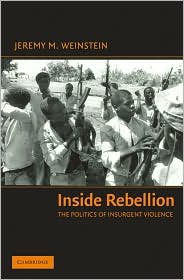 Weinstein, Jeremy M. 2007. Inside Rebellion: The Politics of Insurgent Violence. Cambridge: Cambridge University Press.
Weinstein, Jeremy M. 2007. Inside Rebellion: The Politics of Insurgent Violence. Cambridge: Cambridge University Press.
Jeremy Weinstein’s Inside Rebellion seeks to reveal why some insurgencies are far more violent against civilian populations than others. In other words, why are some civil wars so much more brutal than others? His explanation centers on the organizational challenges associated with insurgencies—particularly, their access to material resources. Rebel organization poses five main challenges: recruitment, control (of fighters), governance (of civilians), violence, and resilience. His theory is that “rebel groups that emerge in environments rich in natural resources or with external support of an outside patron tend to commit high levels of indiscriminate violence; movements that arise in resource-poor contexts perpetrate far fewer abuses and employ violence selectively and strategically” (7).
Weinstein explores these five organizational challenges through the historical examples of four insurgencies: Uganda’s National Resistance Army (NRA), Mozambique’s Renamo, and Peru’s Sendero Luminoso. Sendero provides two cases: the national movement as well as the regional committee of the Upper Huallaga Valley (UHV). Uganda and Sendero’s national organization represent the relatively “less violent” examples, while the other two represent far more violent insurgencies.
NRA and National Sendero were meticulous organizers and engaged in ideologically driven popular education initiatives, while the NRA also counted on certain already established ethnic and ideological affinities. Weinstein explains that both groups emerged from contexts with relatively high barriers for organization and few material resources, leading to a greater necessity on non-material solidarities and incentives and thus creating much more “activist insurgents.” The UHV Sendero and Renamo had little need, beyond some logistical concerns, for cultivating popular support since they counted on firm material support—coca in Peru and foreign state-sponsors in Renamo’s case. Weinstein defines UHV Sendero and Renamo as “opportunistic rebellions” (10).
But Weinstein explains these relationships specifically through the logics of the organizational challenges faced by insurgent leaders. What’s more—and perhaps most controversial in his argument—is that these relationships are substantially path dependent; they are established in the early organizational formation of insurgent groups and remain relatively steady and extremely difficult to change due to the expectations of both civilians and the rebels themselves. (In one of the final chapters he examines some potential counter-examples—Angola and Colombia—but concludes that they do not upset his main claims.) The availability of resource endowments cuts short—or reduces the incentives for—the cultivation of ideological support and social mobilization.
Is Weinstein’s a “resource curse” argument? Yes, but at times Weinstein is more nuanced:
While resource wealth at the country level is perhaps a necessary condition or the emergence of groups that employ economic endowments to motivate participation in insurgency, it is not a sufficient condition. An organization’s initial stock of economic and social endowments and its decisions about how to utilize them may be themselves a function of leadership, ideology, and strategy. A convincing explanation for variation in rebel behavior thus must account for how differences in resource environments (at the country rather than the group level) shape the nature of the competitors that emerge in civil conflict. (328)
More than linking violence to resources, Weinstein wants to link resources to particularly brutal violence: “I have identified an additional resource curse that plagues developing countries: where combatant organizations can access economic resources with which to finance rebellion, they face few (if any) incentives to strike important and constraining bargains with civilian populations” (342). “This study thus complements recent research by the World Bank that pinpoints resource wealth as a proximate cause of civil war…But resource-rich states are not only more likely to face civil conflict, they are also more likely to be challenged by opportunistic insurgencies – groups organized around short-term benefits that are prone to use high levels of coercion and force” (342).
